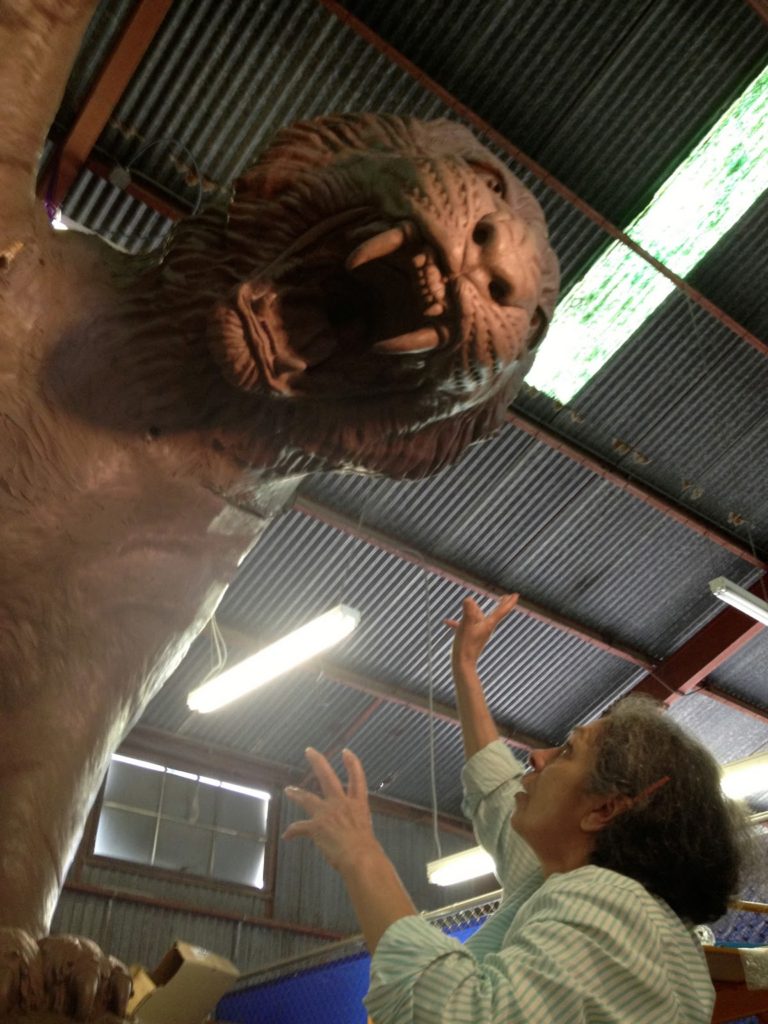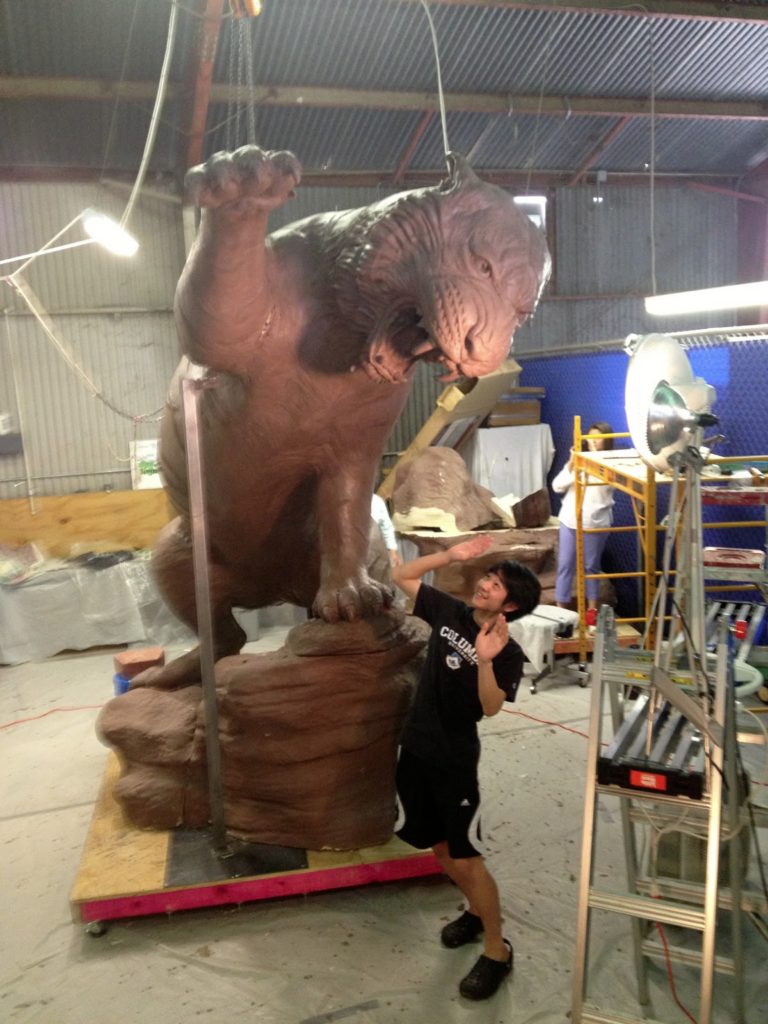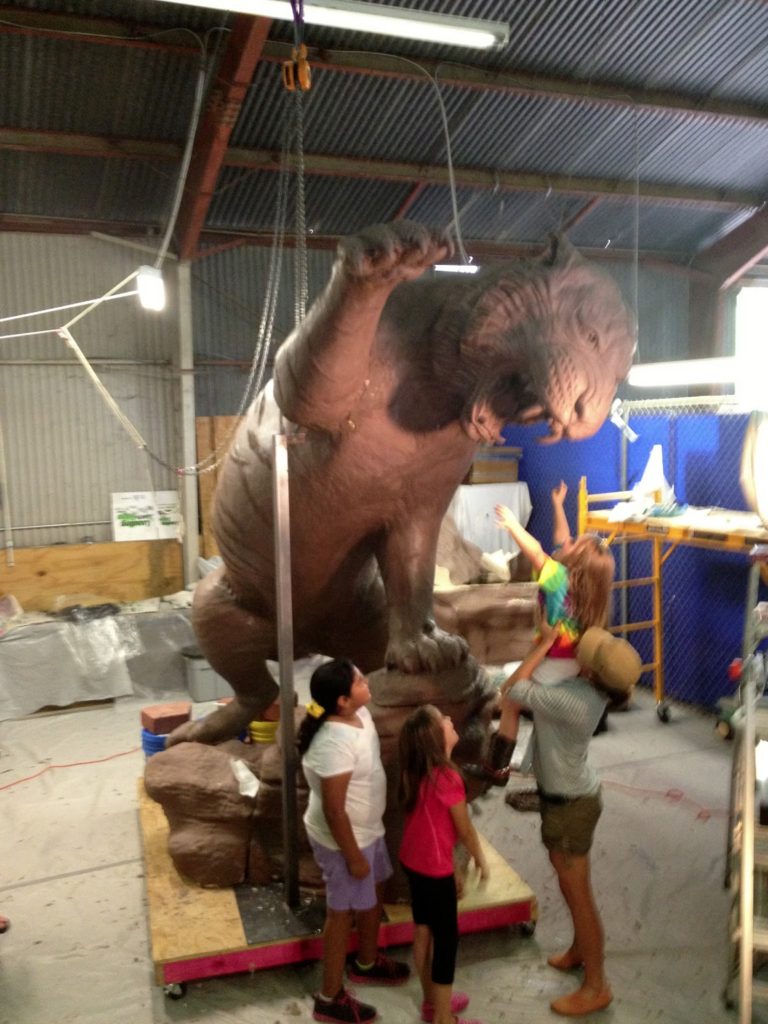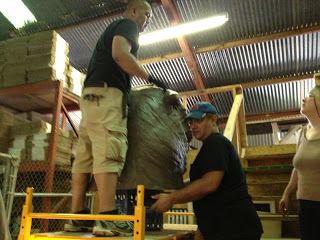CNC Milling And CarveWright Conference
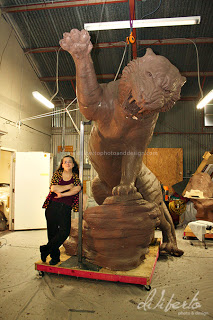
I could have done it without the use of CNC
milling. Oh yes, please note there is another
3 foot of rock that goes under this sculpture.
I have been compiling information and resources for a book that I am writing that talks about incorporating digital and traditional process in art. I call this marriage of the two -Tradigi art. I have been trying to educate others on the process of using 3D technology for a few years. Mike de la Flor and I wrote Digital Sculpting With Mudbox Essential Tools and Techniques and spent a chapter talking about 3D scanning, printing and milling. Our book, I believe, was one of the first that talks about how to get virtual pieces out of the computer and into a physical form. When I first started to do this, many CG people would ask, “Why do you want to get your designs out of the computer?” These are people who use the computer generated designs in movies, video, gaming etc. Without bringing virtual pieces into a physical world my designs are pretty much worthless to me.
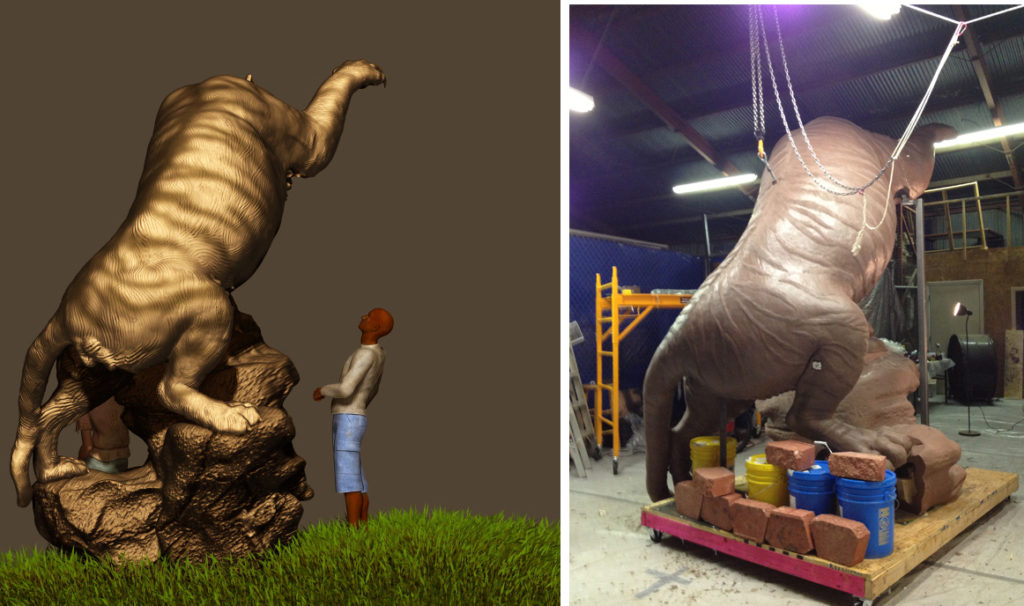
created in the computer and the milled out foam
covered with a fine layer of clay.
Once the client approves the clay the sculpture
is taken into the lost wax method of bronze casting.
I am inspired to educate others on how to do these things and the possibilities of incorporating this type of work into their traditional studios. Here is a pdf of a 2008 article in Sculptural Review that I wrote about the process of CNC milling in art.
I have been using CNC milling of foam for a few years now. My two primary vendors are Synappsys in Oklahoma and Across the Board Creations in Canada. I have described some of my processes in a You tube video on the subject. I also have project blogs for the last several projects that talk about using the CNC milling of foam with my designs. I used CNC Milling on the Prairie View Panther, the Evelyn Rubenstein Sculpture for the Jewish Community Center and most recently on this enormous sculpture of the Tiger for Grambling State University.
I have also watched in fascination and excitement about the CNC Milling in Stone. All of these tools expand my tool set and save a sculptor’s hands from very damaging wear and tear.
Steven Ramirez of Smash Designs introduced me to the CarveWright . He was one of our speakers last year at 3DCAMP Houston. Once I saw the CarveWright and it’s possibilities I was very, very intrigued. I had been looking for a vendor that might mill my work. I’m still looking for this type of vendor. I had also been searching for others who had been using CNC milling in their artwork. I wanted to feature them in the book, and yes, I am entertaining getting a CarveWright of my own.
3DCAMP is a 3D symposium on everything 3D. It is hosted this year by the department of Architecture at the University of Houston. The date is October 5, 2013. The cost last year was only $15. and this year will be raised to $30 for professionals and $15 for students. A great prices for so much information and resources in one space. We had hoped that CarveWright might be a sponsor for last years 3DCAMP event, and would be able to discuss more about milling at 3DCAMP.

What is a CarveWright? It is an affordable consumer CNC milling machine that gives you the opportunity to design your own patterns, or use patterns provided with the machine and mill them out in many different materials. When learning about the CarveWright Conference, I was intrigued, not only because of my desire to try this machine, but also because I really wanted to gather more information for the book.
I learned many things from attending the CarveWright conference and was intrigued by the many people that I met. Of course, I’m looking at this tool and thinking, how can I push it like no one has ever pushed it before. How can I sculpt using this tool? I’m not the only one thinking about pushing the boundaries as Joe Lovchik, one of the owners of CarveWright was displaying how to use the tool to not only carve wood, but carve other things like foam, plastic and even wax. He showed how he used the CarveWright to make a pattern for pouring concrete, stamping leather, creating incredible lithophanes. The possibilities really made your head spin.
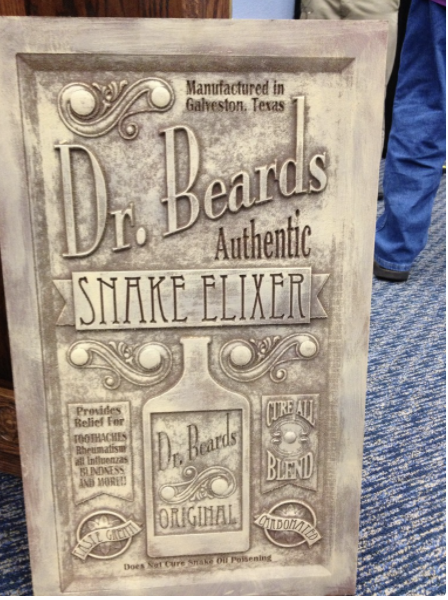
Besides learning the software that comes with the program, some of which I hear is some of the best for CNC milling, we heard what others were doing with the CarveWright. Michael Tyler displayed some of his creations and talked about inspiration. I loved learning about the stains and patinas he is using called Sculpture Nouveau. They are breathtaking! Joe Ragsdale talked about carving photos in wood. The feature that I think would be easily applicable to my own studio process is the carving of letters. I often get asked to incorporate type into my sculptures. This is not an easy task and takes a great deal of handwork. For example, the newspaper that the newsboy holds has copy that is individualized for each client that purchases this bronze. I have to change out the headline and subhead so that it is pertinent to those who are purchasing this bronze. You can be sure that the next time this happens I’ll be scanning this newspaper and carving it with a CarveWright. Oh, yes, I failed to mention, the CarveWright has a point scanner that you can purchase as well.
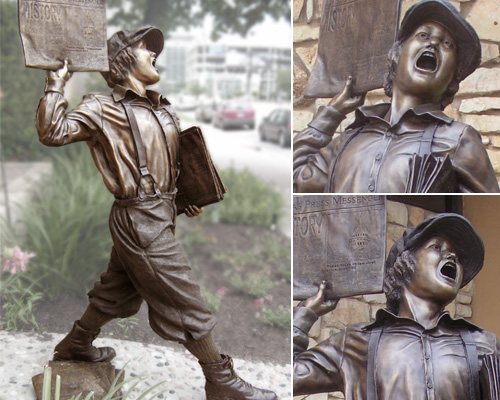
The possibilities and relationship between me and CNC and me and CarveWright are just beginning. I hope they will help me to push the limits of their product with my designs and look forward to working with them on this. I can’t wait to see what I come up with for the book. My head is already thinking in that strange 3D way. Thanks CarveWright for the information and the inspiration.
_______________________________________________
Bridgette Mongeon is a sculptor, writer, illustrator and educator as well as a public speaker.
Her blog can be found at https://creativesculpture.com.
She is the vice chair of the planning committee for 3DCAMP Houston 2012 http://www.3dcamphouston.com
She is also the owner and creator of the God’s Word Collectible Sculpture series http://www.godsword.net
Follow the artists on twitter twitter.com/Sculptorwriter and twitter.com/creategodsword
Listen to The Creative Christian Podcast or the Inspiration/Generation Podcast
Click on Podcast Host Bios for a list of all podcasts.
Back At The Studio
Once all of the torso molds have been done we have moved the entire operation back to the home studio to work on the legs, head, tail and rocks. it is great to be back at the home studio with AC. It is a whirlwind of activity.
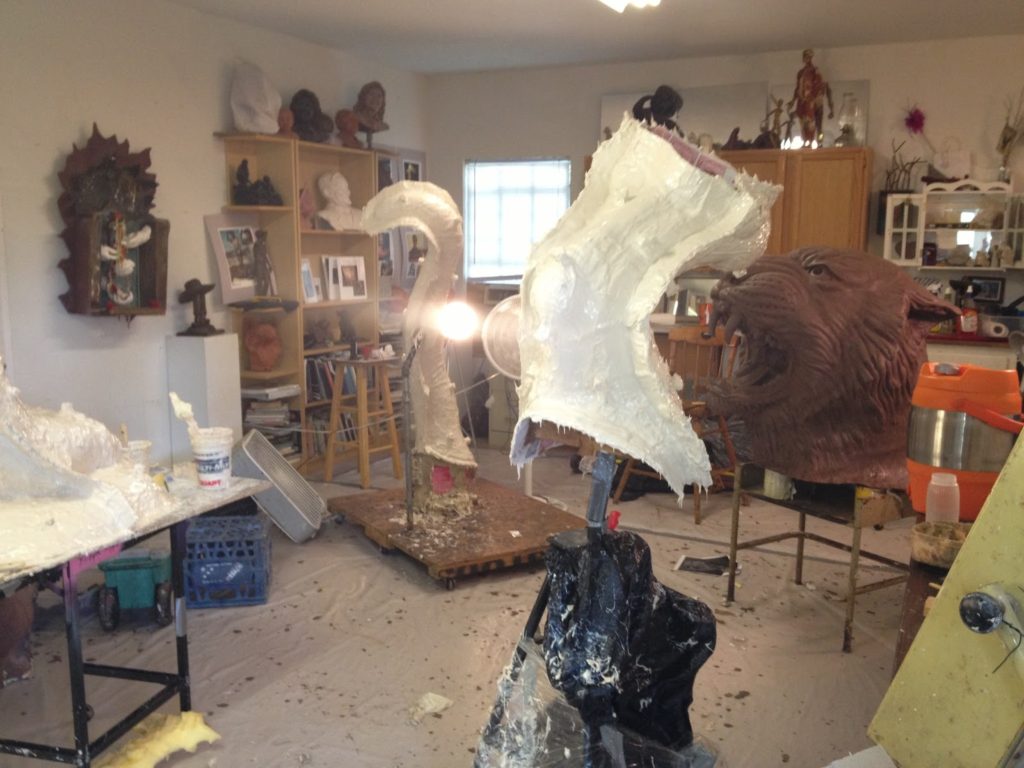
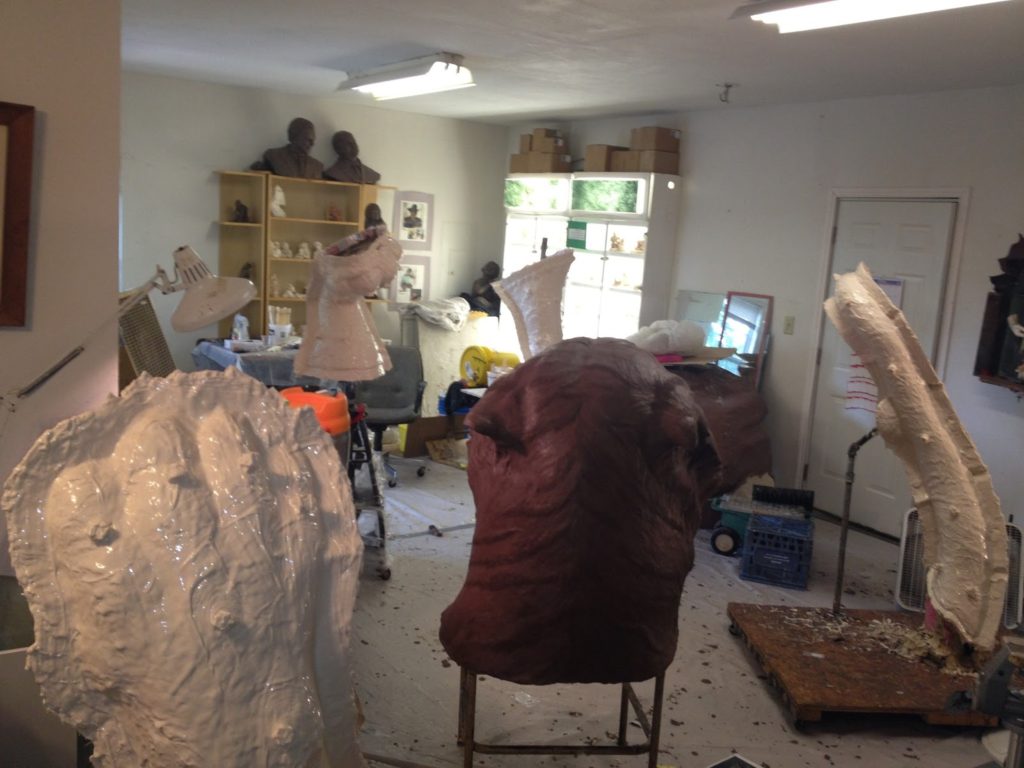
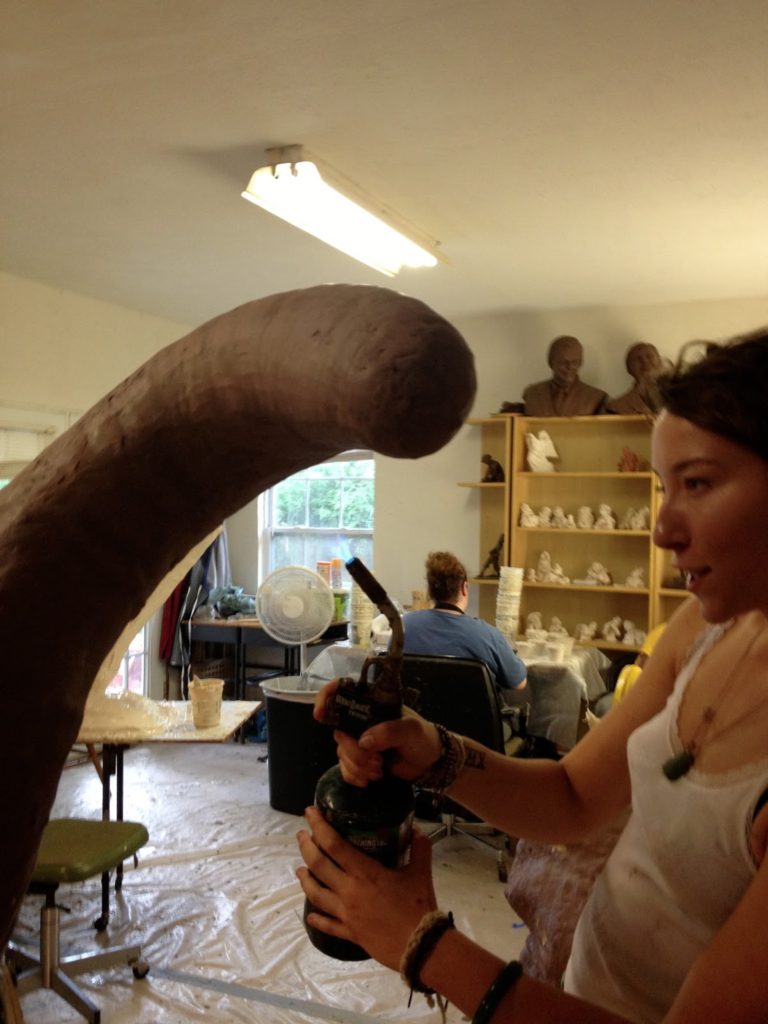
done to the tail while moving it back to the studio.
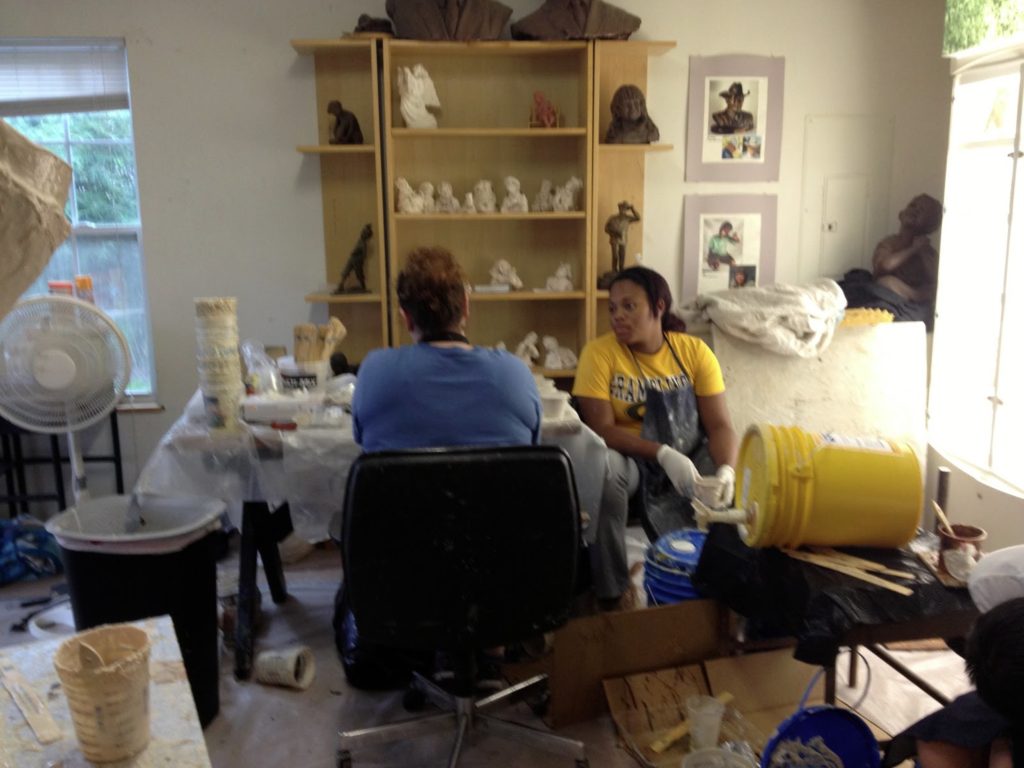
Gutting A Tiger
Both a rubber mold and a fiberglass mother mold have been applied to the torso. With this part complete we are about 1/3 the way through the mold making process of the Grambling Tiger. This week we separated these molds from the clay sculpture. Each mold had to be cleaned. The rubber is scrubbed and the fiberglass mother mold sanded. Then all of the pieces are put together. Even though we have these molds it is important to save the clay just in case something should happen to the molds. So this is our visual documentation of what is done this week.
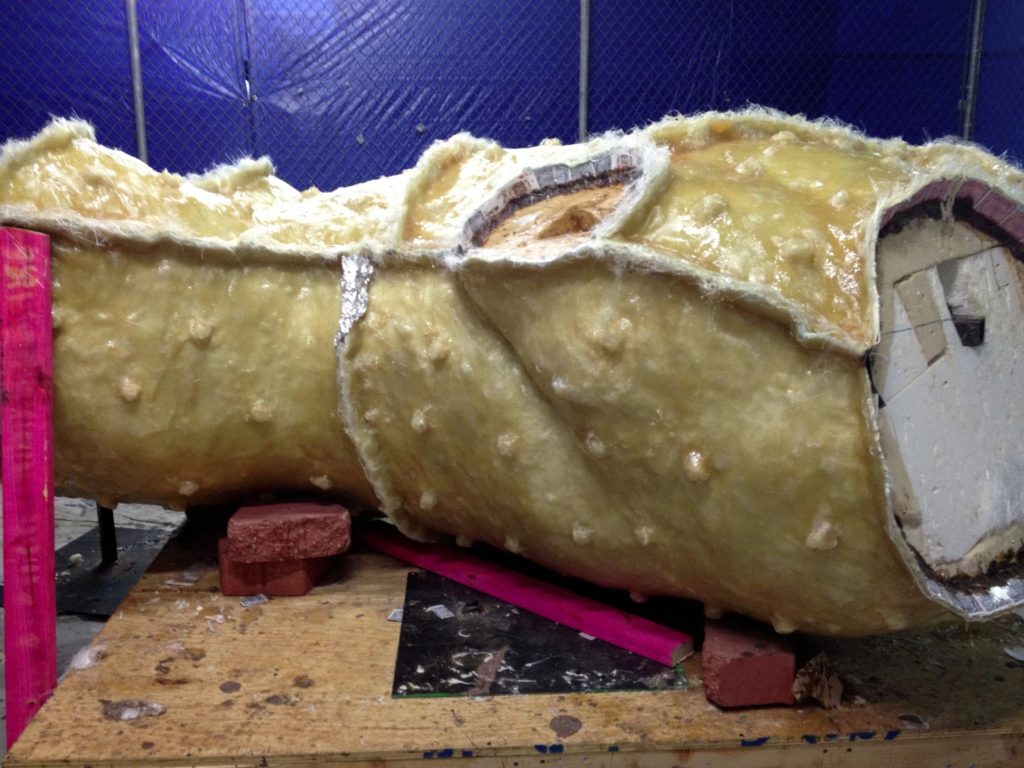
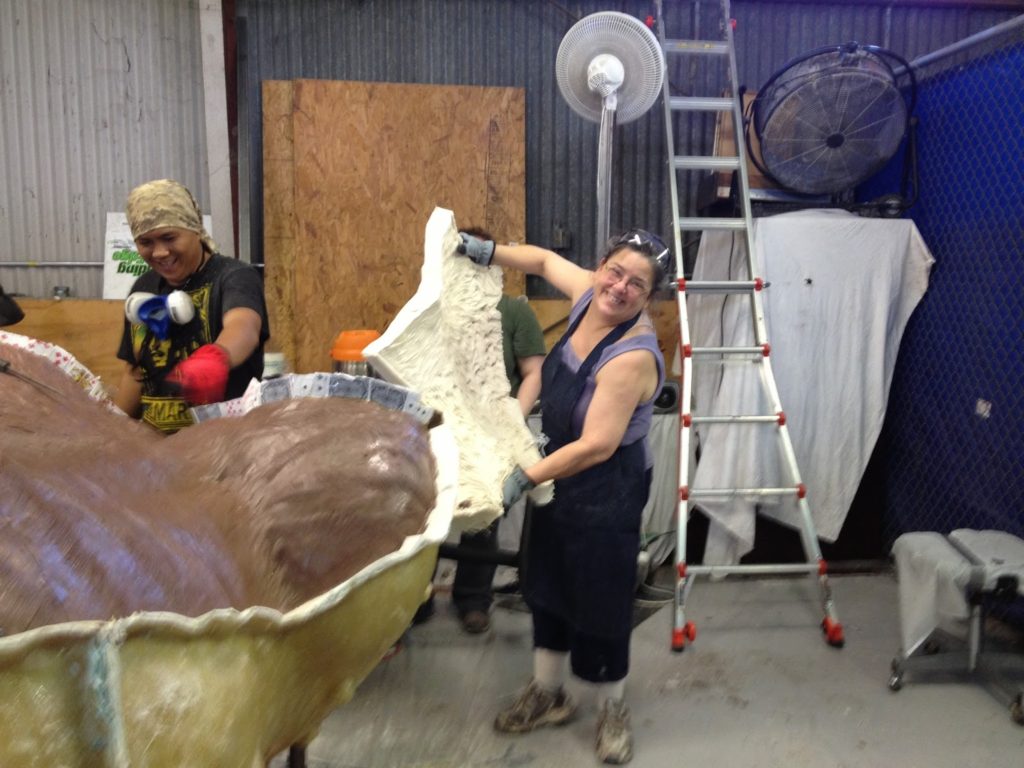
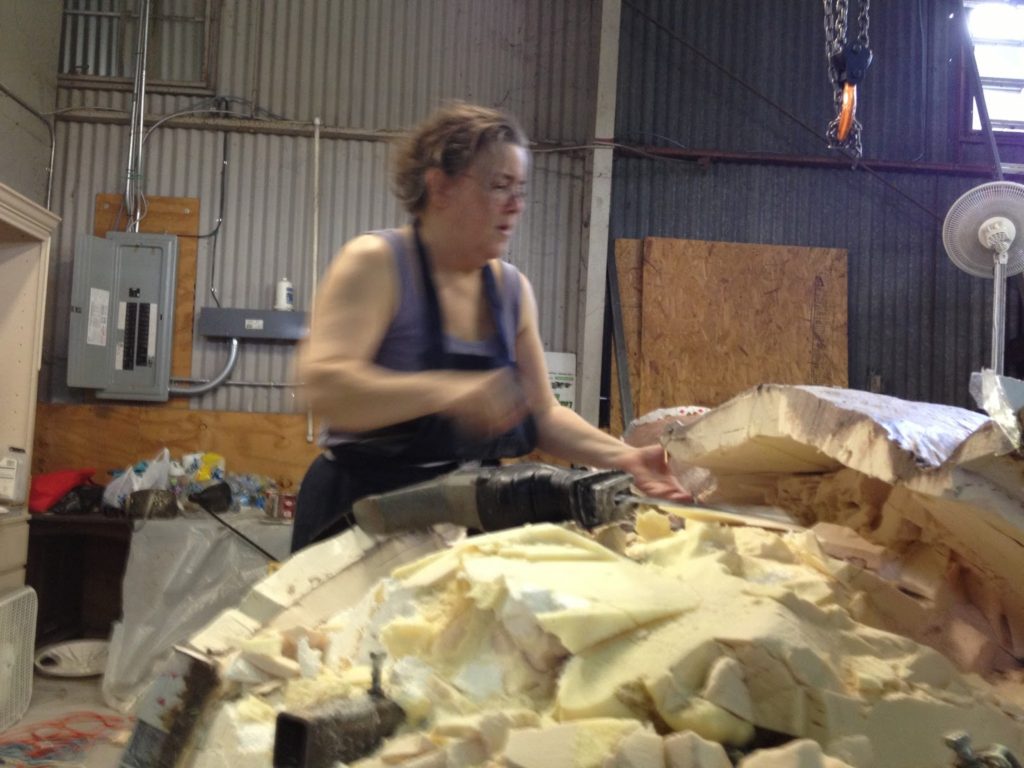
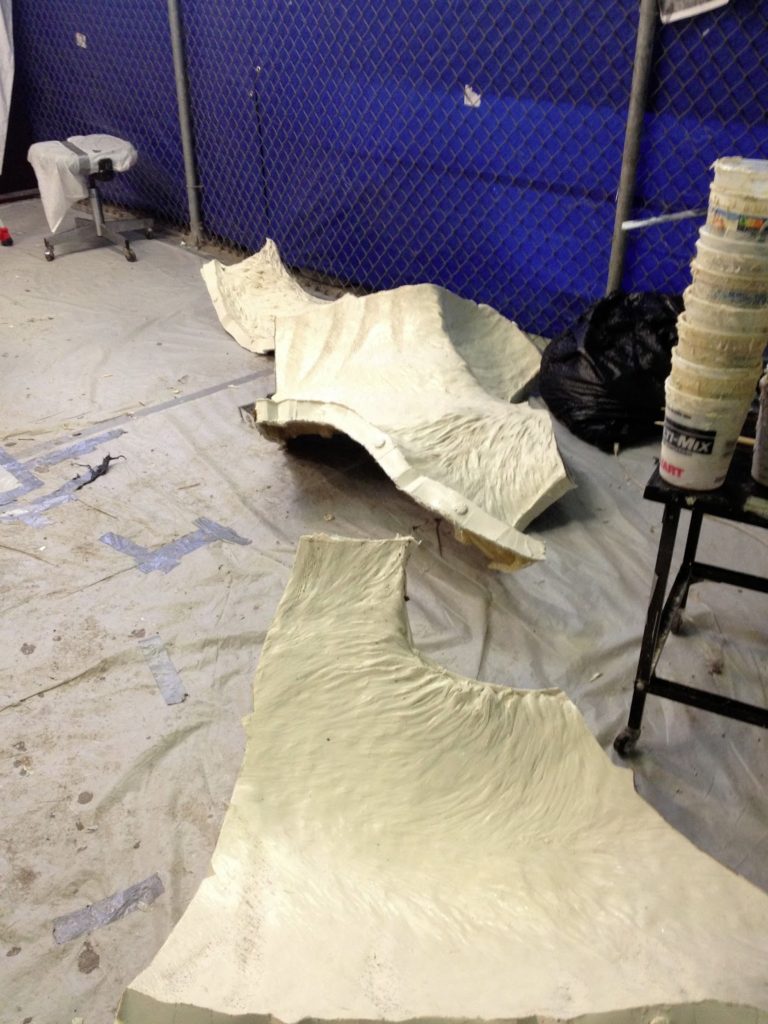
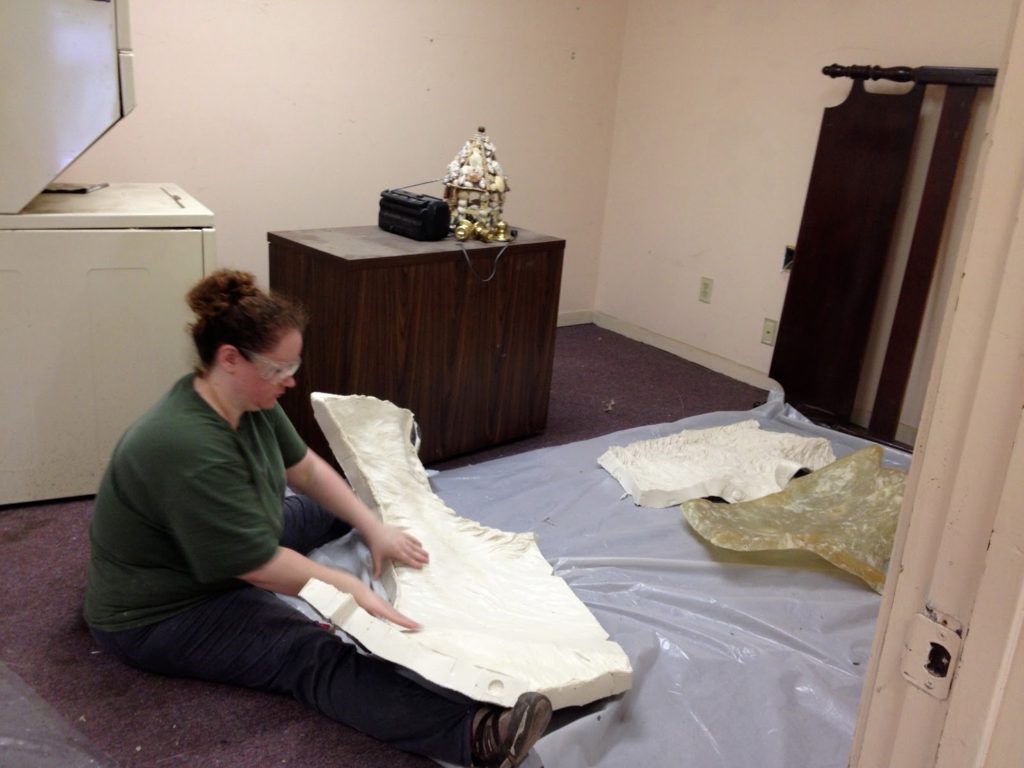
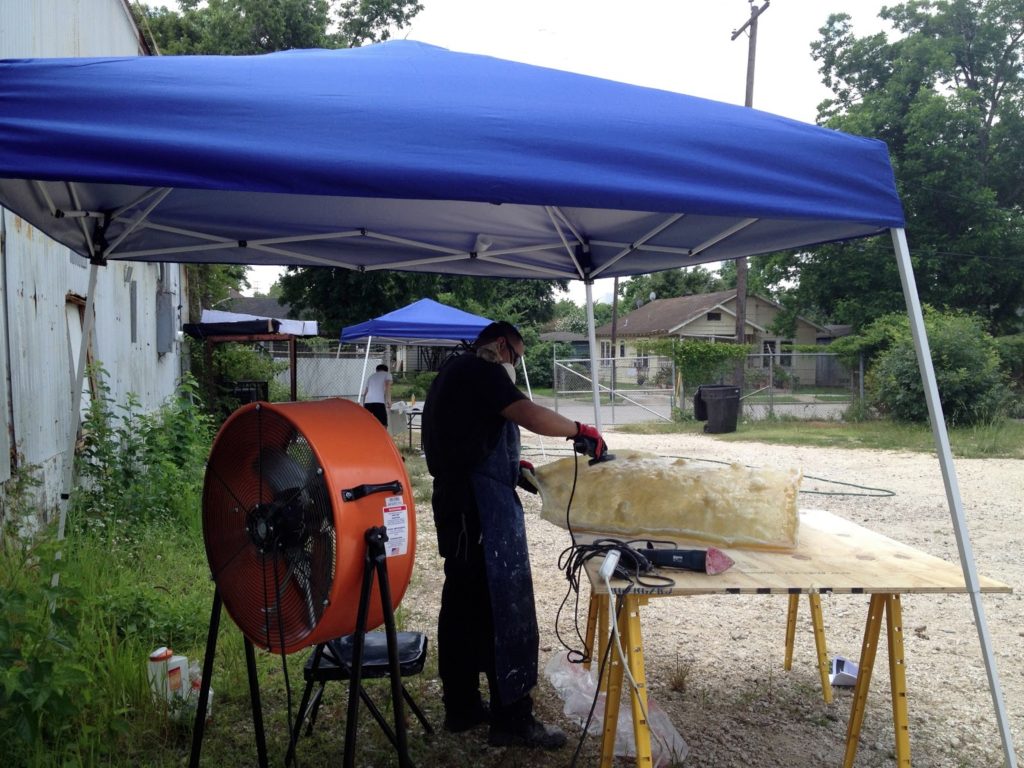
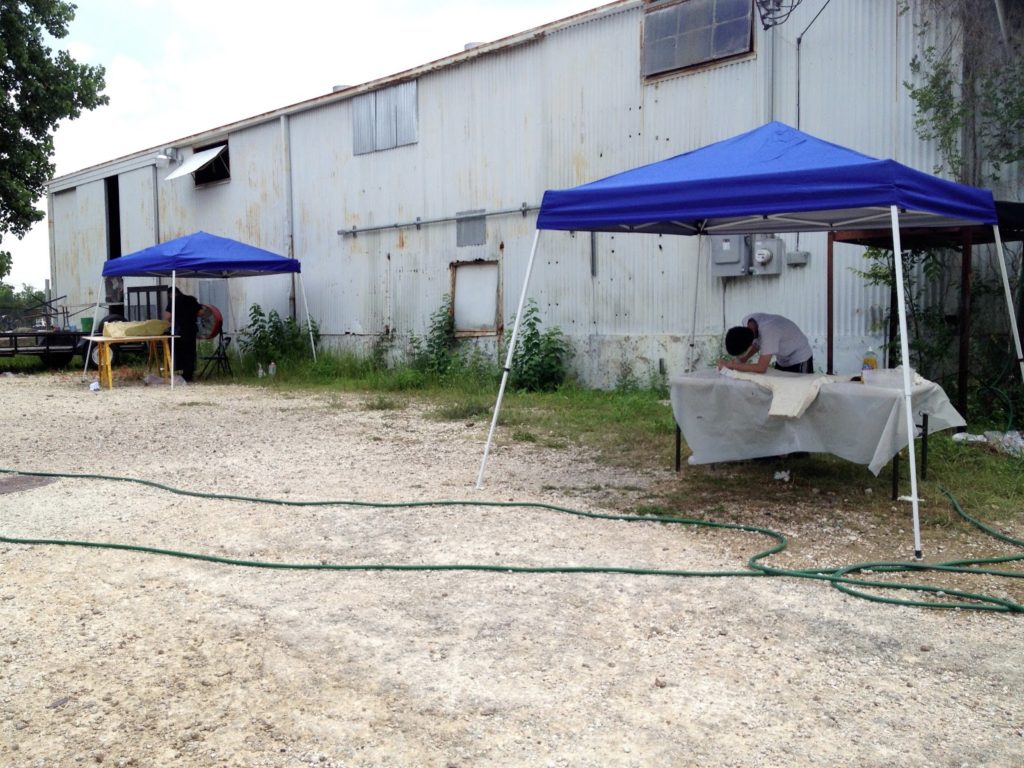
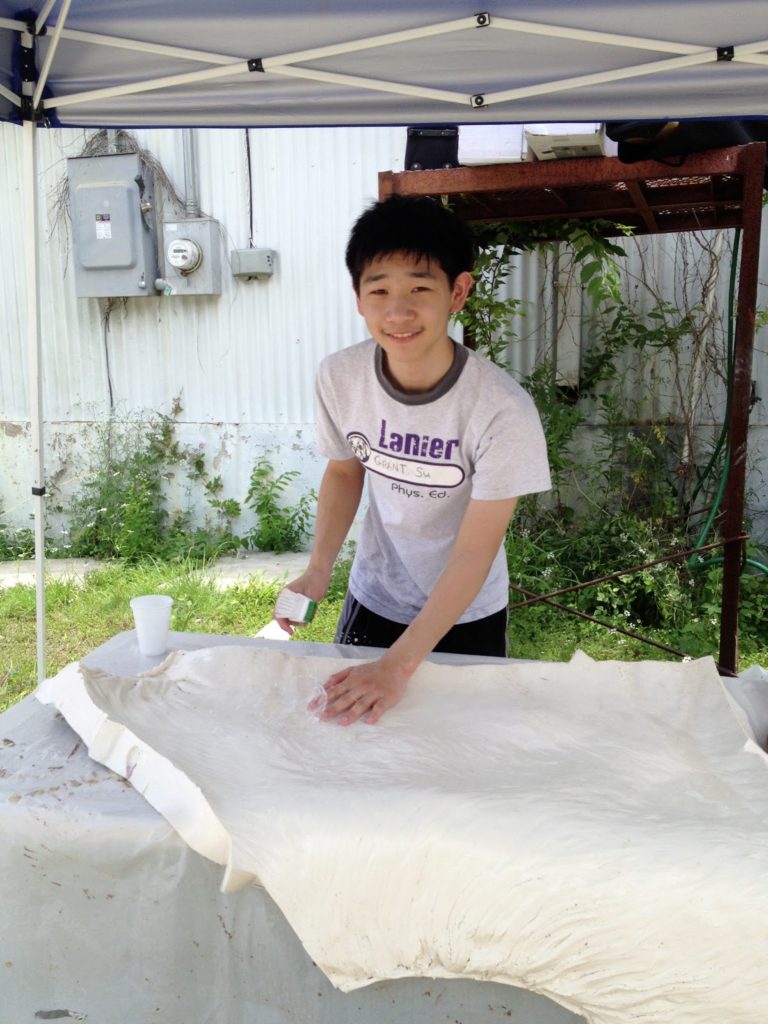
Flipping The Kitty!
It has been a busy week. When I finally get to sit down in front of a computer to write these posts I feel so relaxed. I’m in AC. I’m not hauling, pulling, lifting or sculpting. I’m not in a hot warehouse.
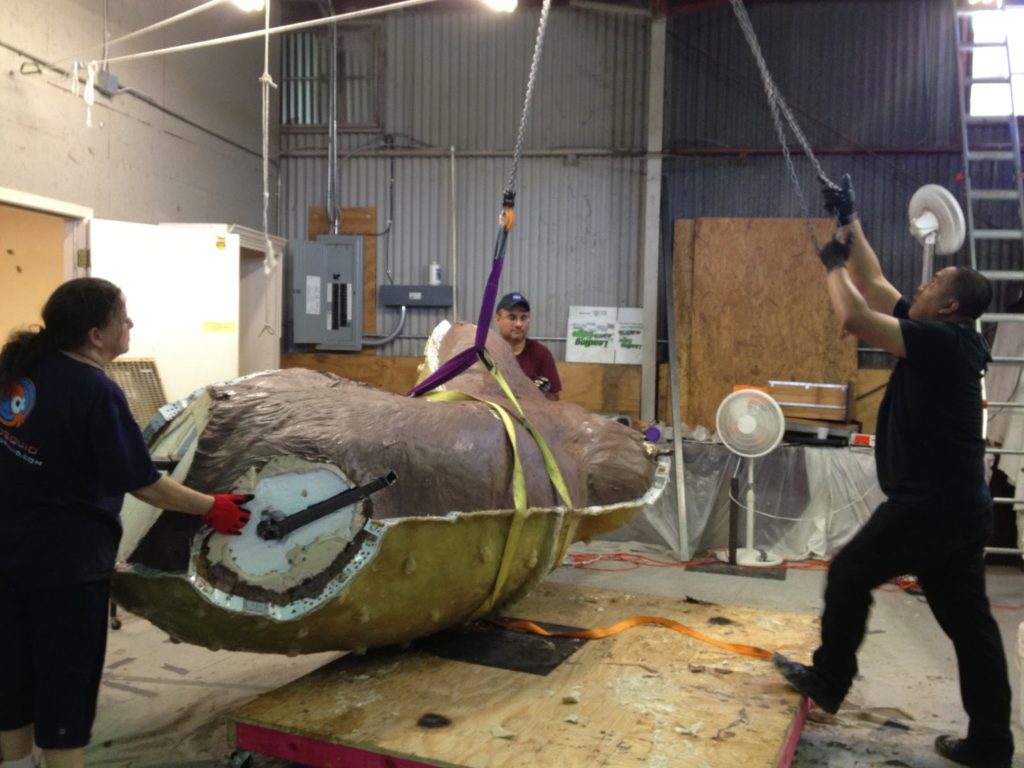
We have made many accomplishments this week. The top part of the big cat torso has both a rubber mold and am other mold. See previous posts for this explanation. The big challenge was to flip the entire sculpture and take it off of the winch. The cat has not been off a winch for weeks, and it weighs a great deal more than it did going on as a foam piece. It was a challenge to figure out how we could do this, but we soon had the “kitty” flipped and supported and I began the job of finalizing the details on the big cats underside. Then we made the mold for this bottom half.
The temperature in the warehouse has reached 102. This temperature is tolerated by myself and my interns as we are forced to wear masks and long clothes to protect ourselves from the fiberglass and resin. Once this part of the mold is done we can move back to the air conditioned home studio where the paws and head await the same process. More to come.
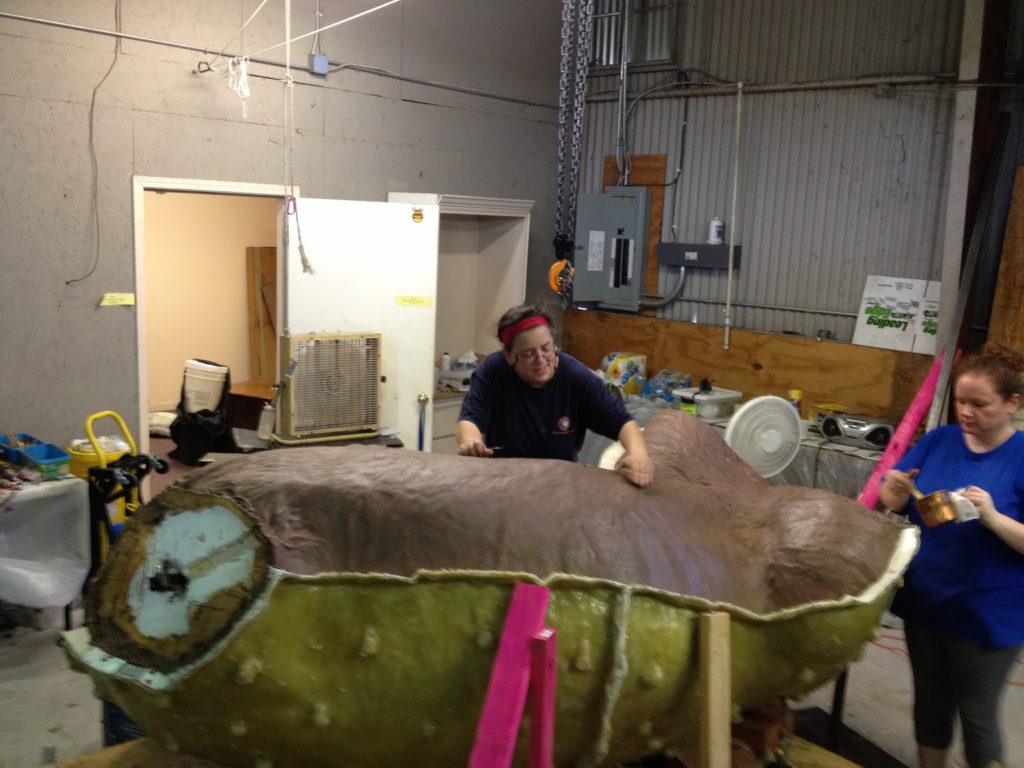
for the final details.
Why They Call It A “Mother Mold”
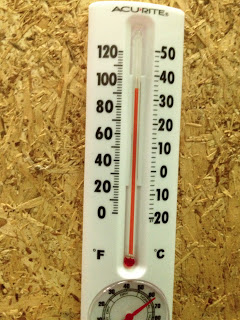
working in fiberglass in the heat.
You have to wear long sleeves,
long pants, aprons, etc.
Oh, we are racing against the temperature. 97 degrees in the warehouse! This temperature is when it is less than 90 outside. Usually the warehouse is 7 degrees higher than the outside temperature. We have moved most of the tiger appendages to the home studio, and do this late at night or early morning when possible. The clay gets very soft in the heat. We will work on the appendages later. For now, we continue with this massive tiger torso.
We now need to make a mother mold of the Grambling State Tiger. A mother mold is called that because it holds the rubber in place. Mother molds can be made of a variety of materials, but we are doing these mother molds in fiberglass.
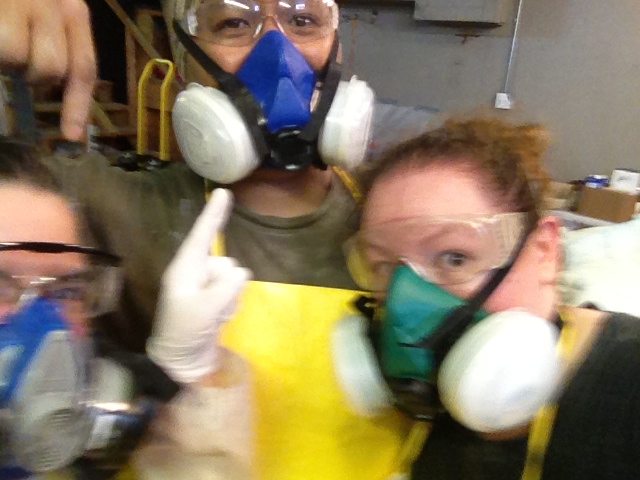
I choose fiberglass because it is lighter. The foundry that is casting this tiger is Shidoni in NM. They work on monuments all of the time. They need larger mold pieces. This is good because it makes our mold making job a little easier. But the mother molds often make the mold sections heavy, plus I will be shipping these mold pieces to New Mexico for casting so we are looking for convenience. Fiberglass mother molds win over a plaster mother mold.
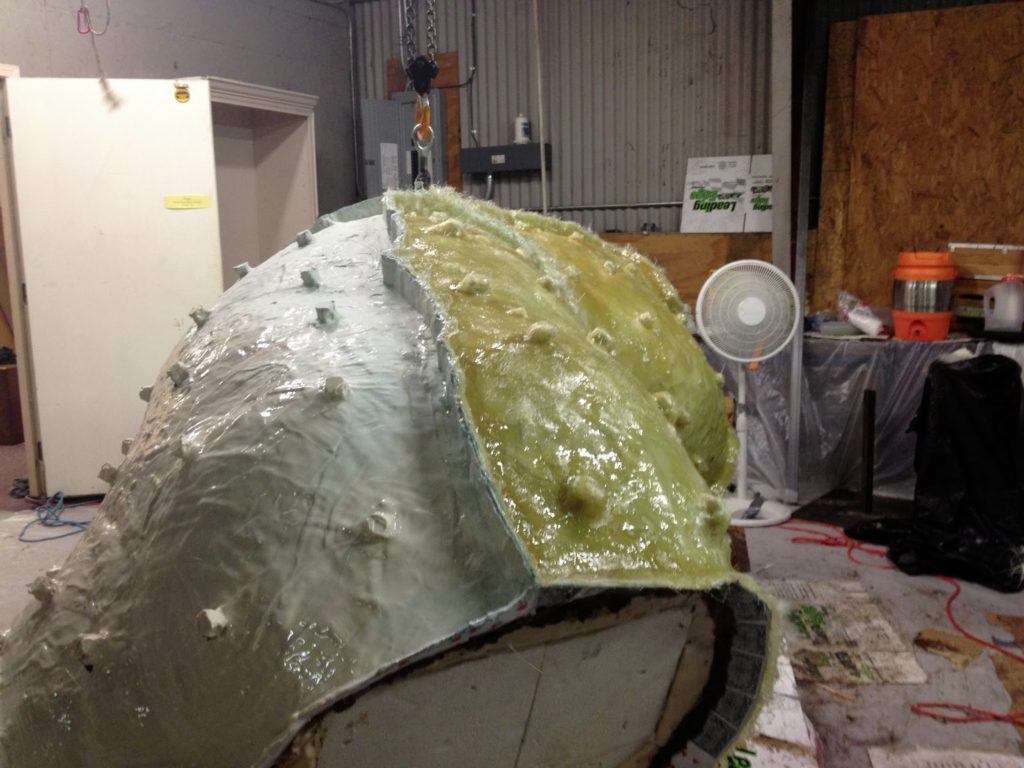
Now The Real Work Begins
Many artists take their creations, once they are complete, like the tiger at the stage that was featured in the last post, and they send them to a foundry. The foundry then takes them into the foundry process. The first step of this foundry process is mold making.
Well, we do our own molds at Bridgette Mongeon Sculpture Studios. Really mold making is back breaking work, and I have had several foundries that have said they appreciate that we make our own molds.
Many ask, “how can you cut up the piece, after all of that work?”
It is very simply, it all a part of the process!
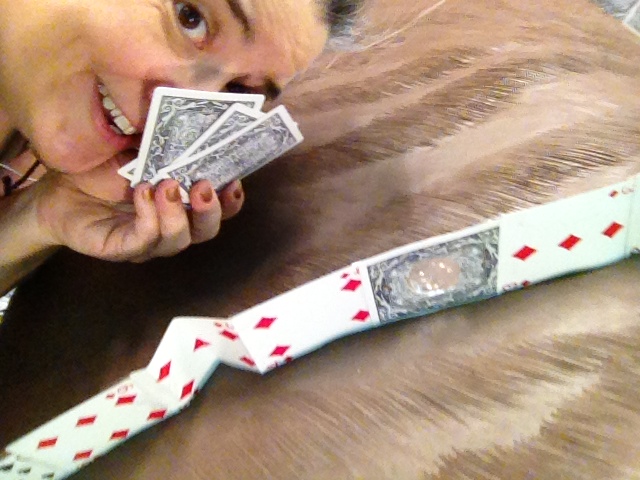
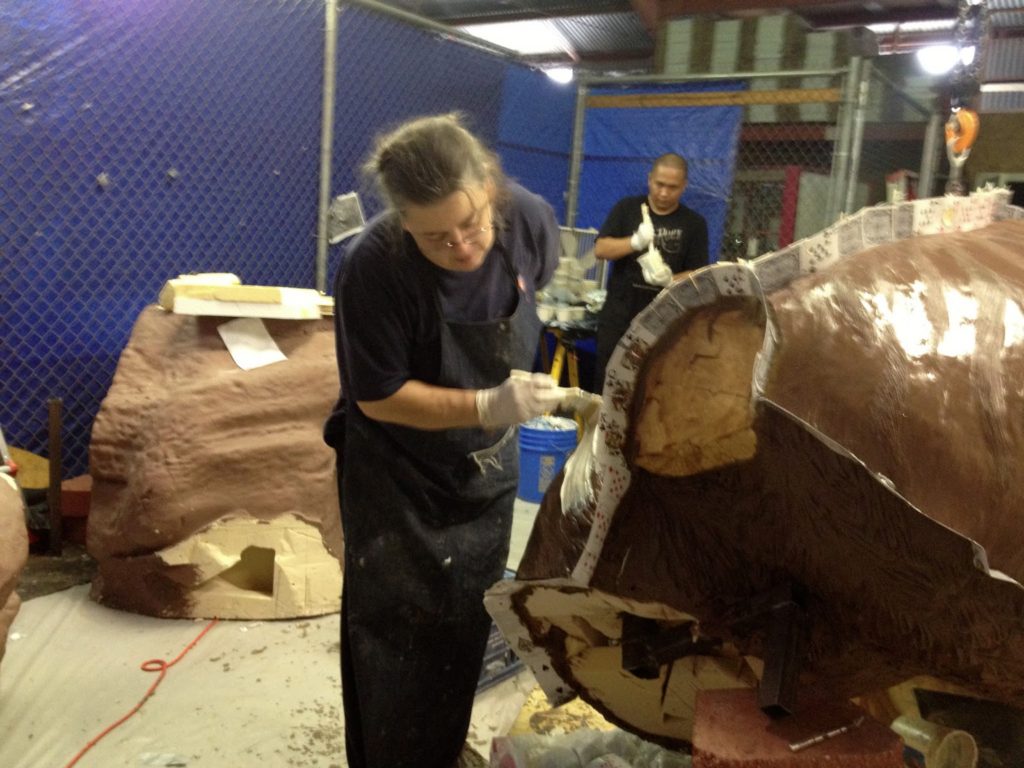
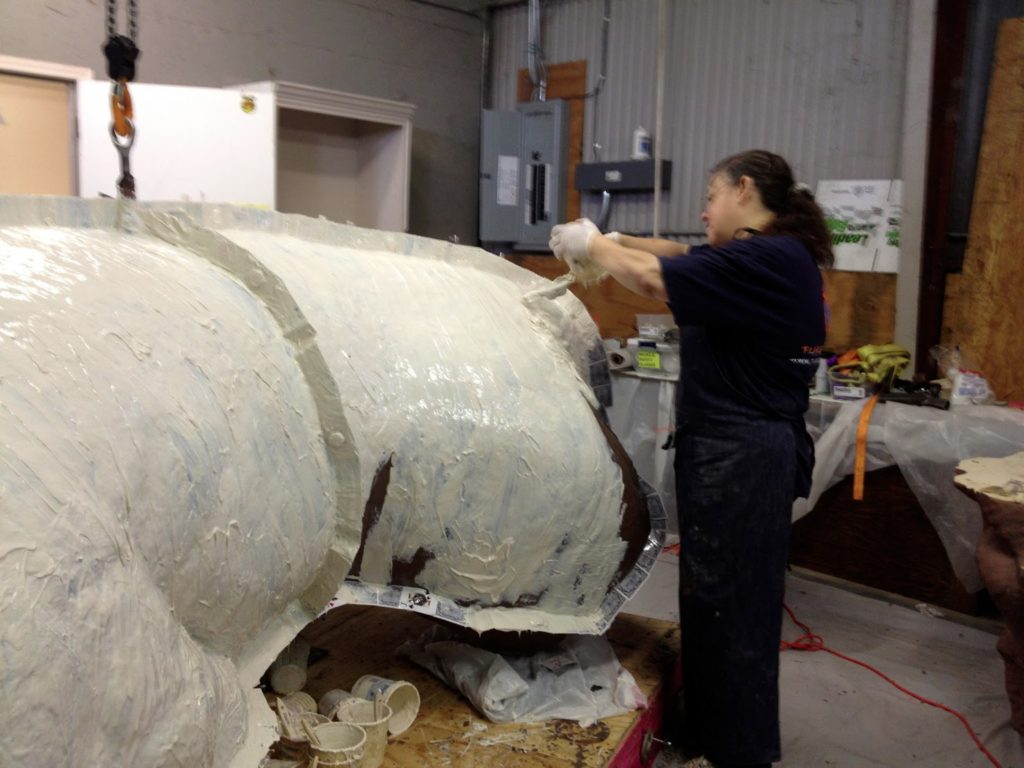
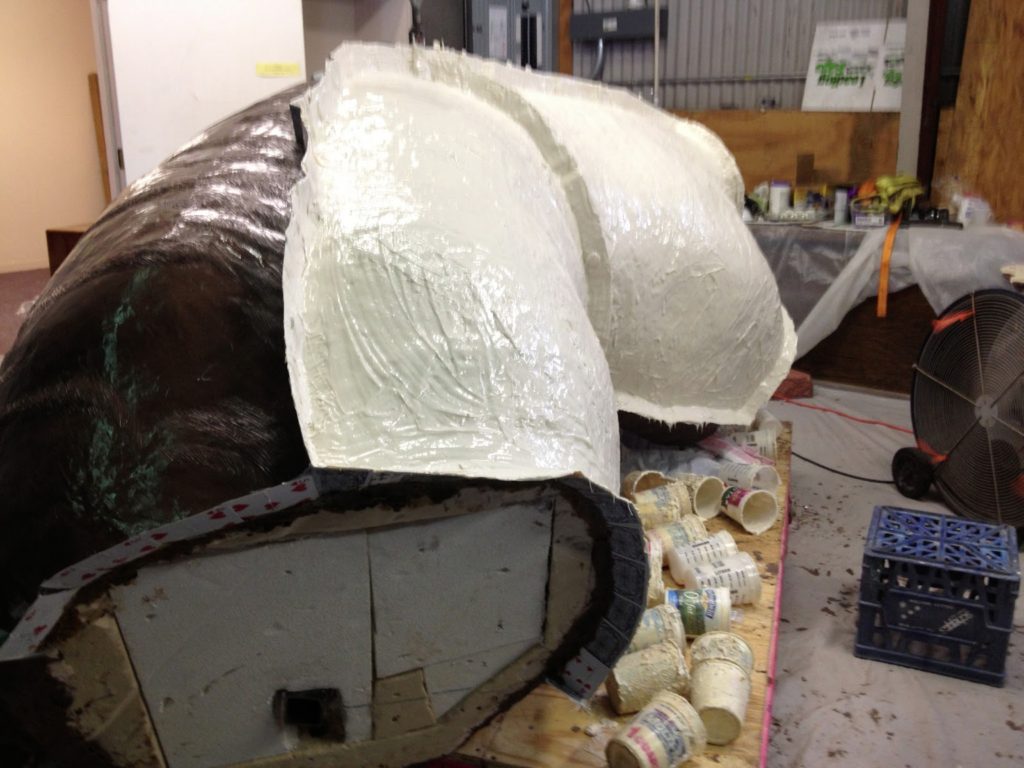
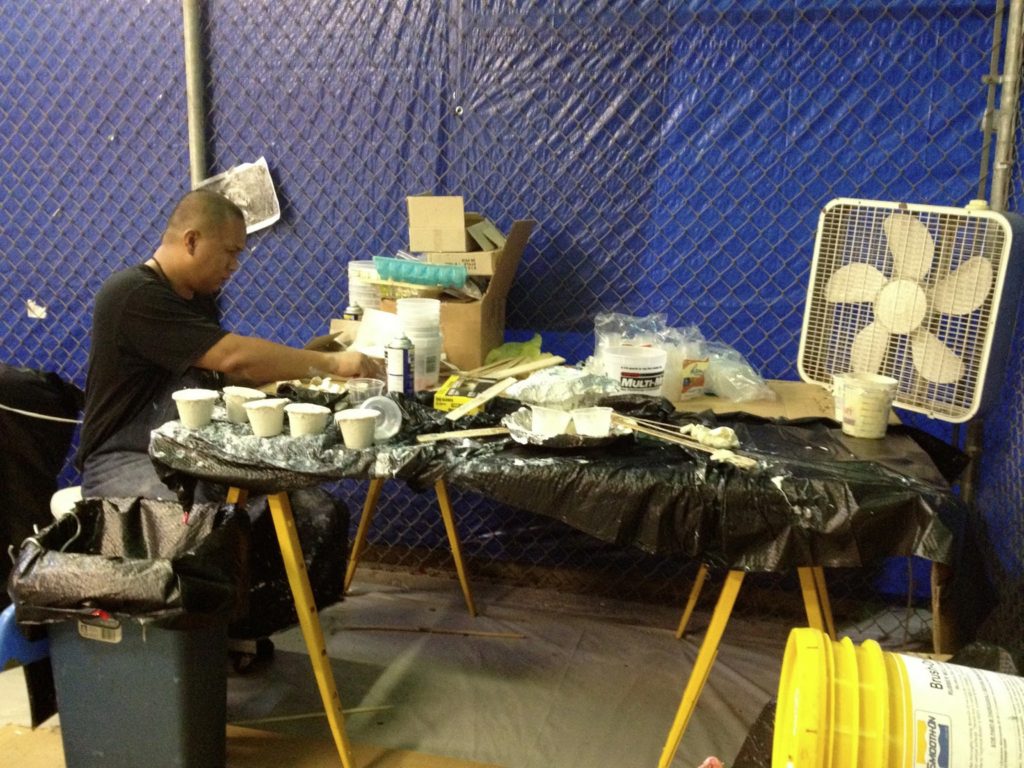
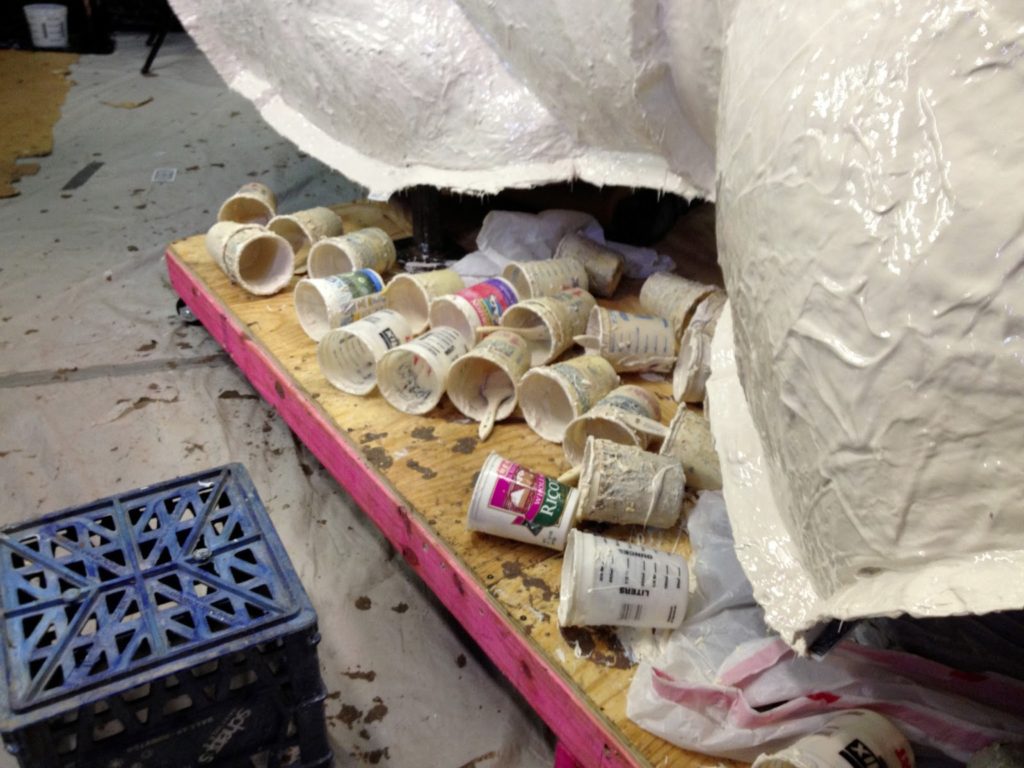
Taking Apart The Puzzle
Once we have approval we can begin the next step, however, we must take the sculpture apart. We do this in the same way that it went together. However, an intern told me later, “it went together much easier than it came apart.” I was thinking the exact opposite myself.
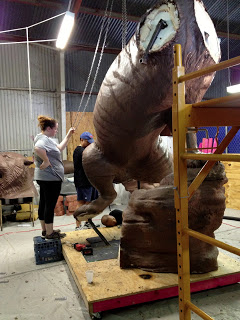
piece by piece. Allison is posted on the
winch to life and lower as needed.
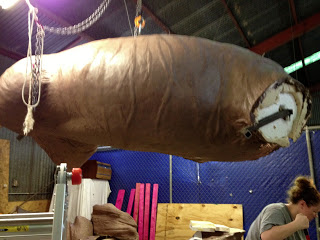
overhead while we clean up the area.
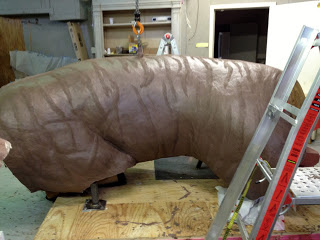
and we no longer have to move them around
I can look at everything and make sure the
detail is perfect before we go to mold.
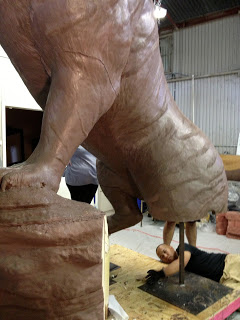
While I make sure there is a clean cut between
piece of the paws.
A Bit More Work
While visitors were coming to the studio, our work did not stop. I had notified Grambling State University before they approved that I intended to make a few changes, and there were details that were not finished. When we were attaching the arm to the body Allison Gonzalez, my lead intern, brought her family to help. A niece, Ingjierd Marquez offered to take my phone and take pictures while we worked. She went up into the loft and shot us attaching the head and arm. I noticed in one of the pictures when we were trying to get the arm on that it really looked better a bit lower. I don’t think I would have ever thought of this had I not seen the picture taken by Ingjierd. Thanks Ingjierd.
Had this been a table top sculpture I might have thought to play with the arm and step back, but stepping back when you are that far up in the air is not that easy. And moving an arm, that is made with foam, but has a metal armature and lots of clay on it, is not that easy.
When I told Allison about my thoughts, she did not hesitate about climbing up so high and helping. Allison, God bless you for your fortitude. She went up on the scaffold and helped me to lower the arm to check it out. I loved it! The sculpture looks more threatening.The tiger is not just raising its arm to attack but the paw is coming down on you! However, this minor adjustment meant that I had to spend 2 days up on the scaffold fixing the arm and the areas surrounding it. Well worth it.
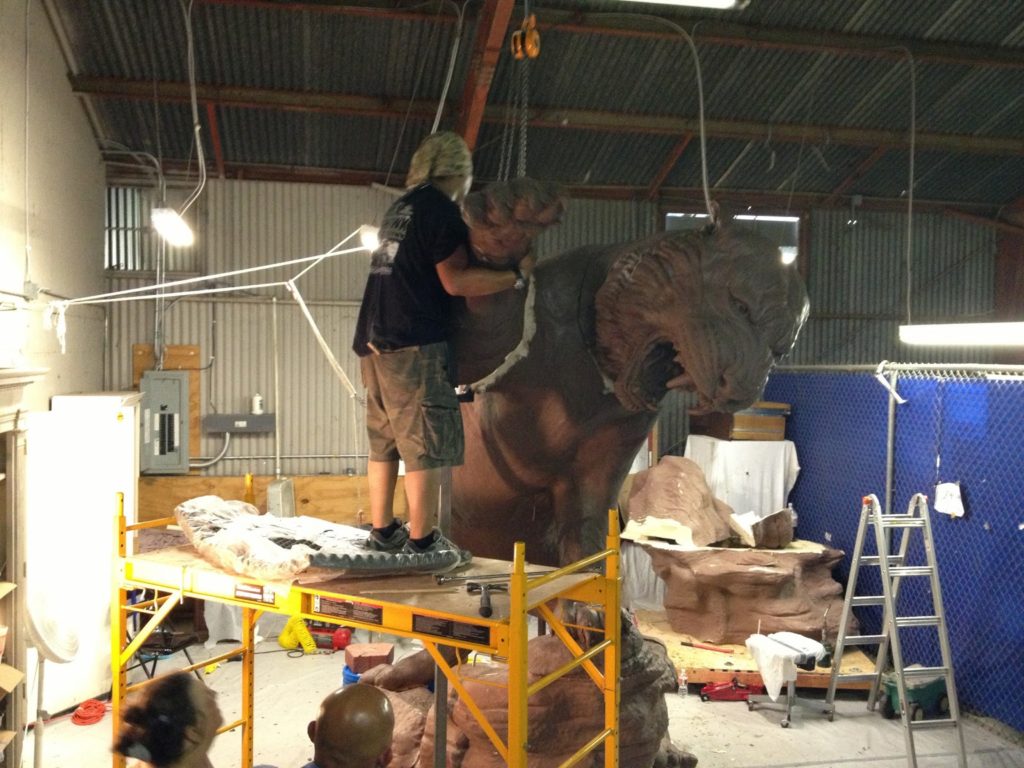
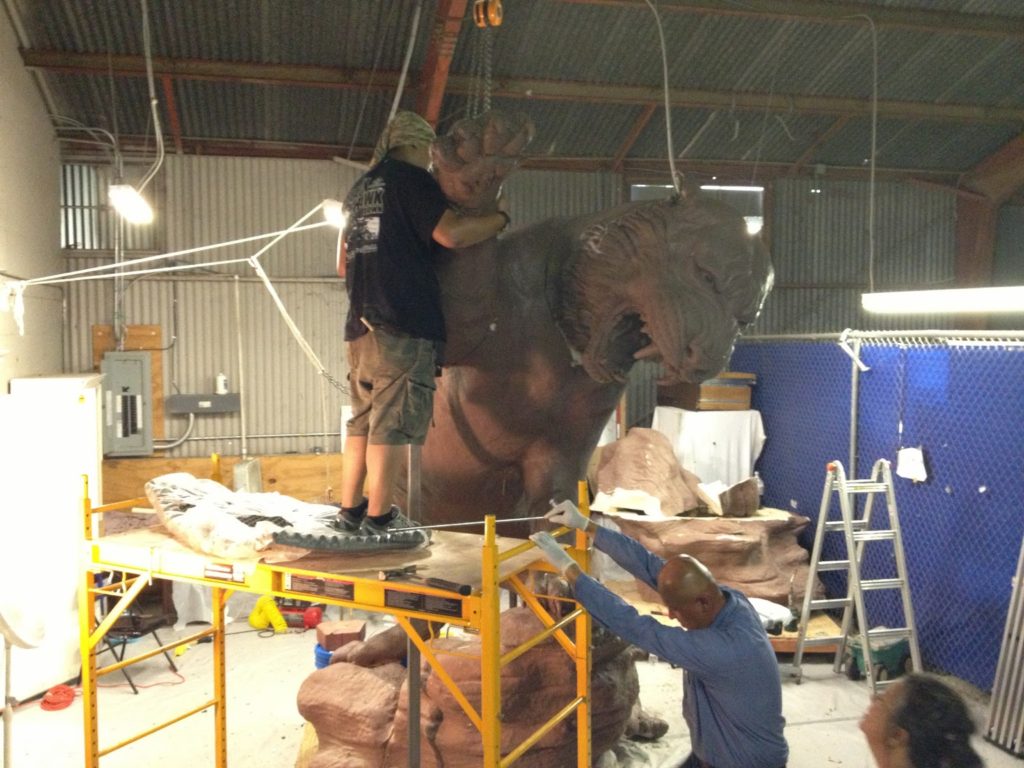
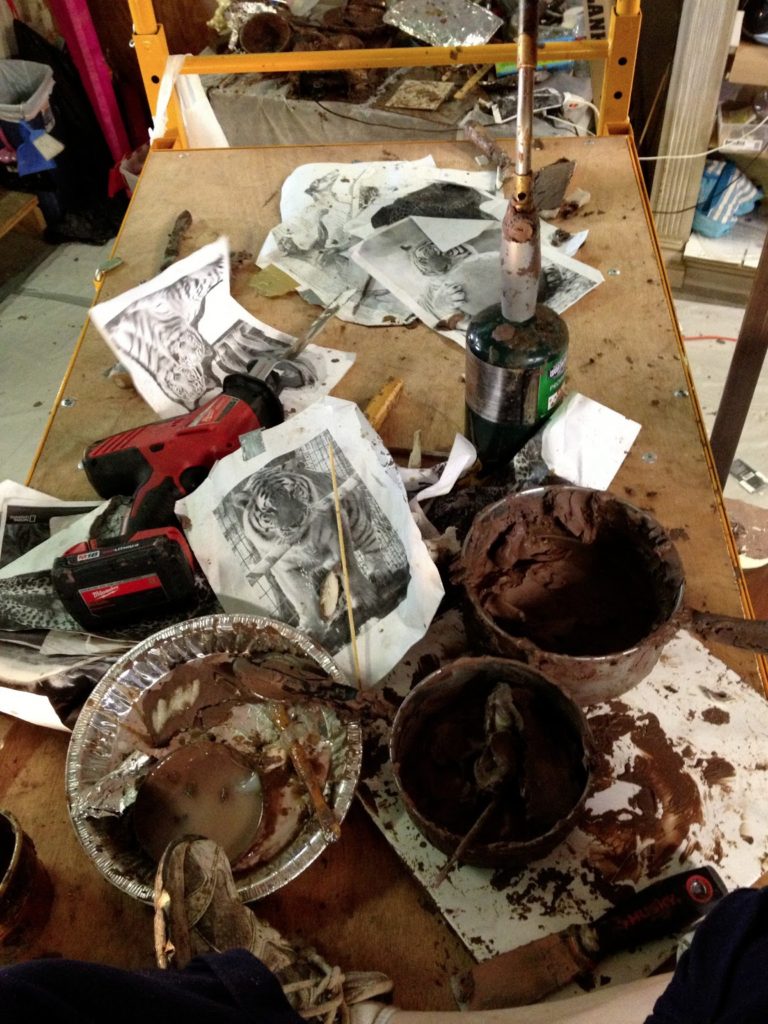
So I sat up here for a few days. My work area the atop of the scaffold.
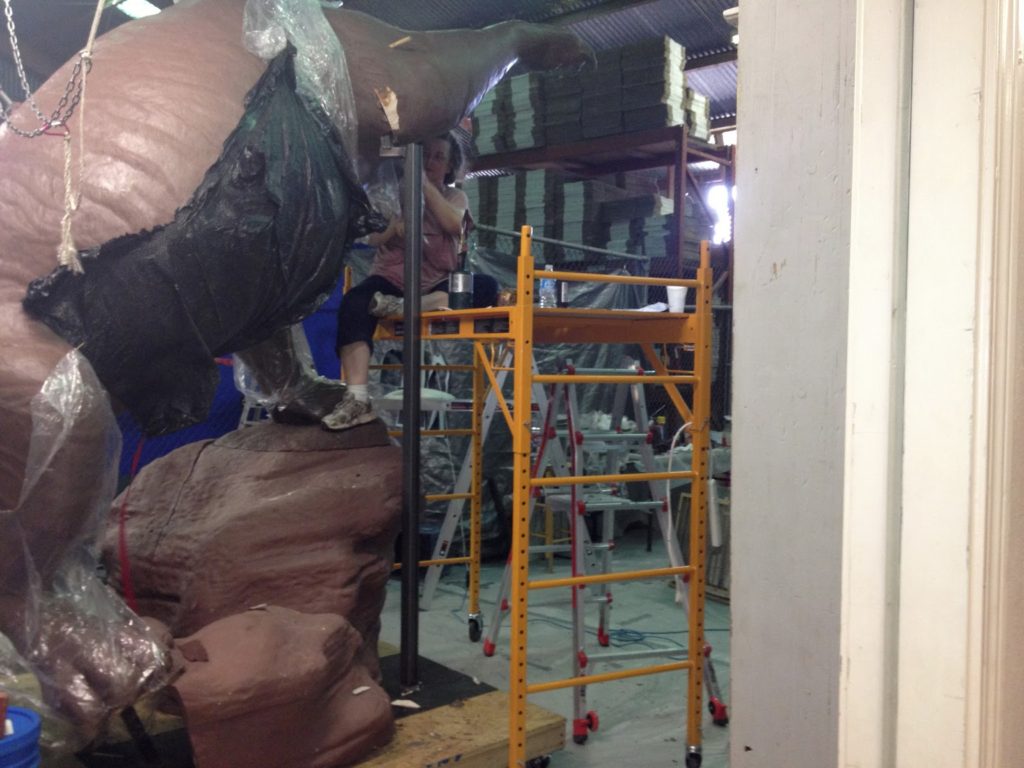
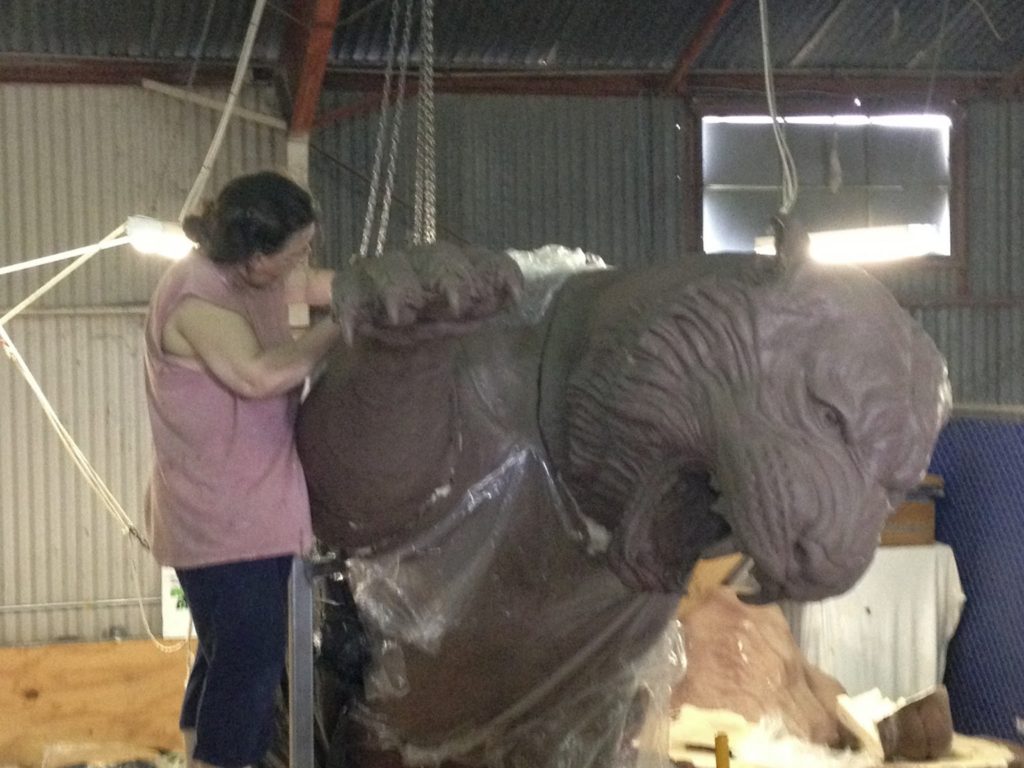
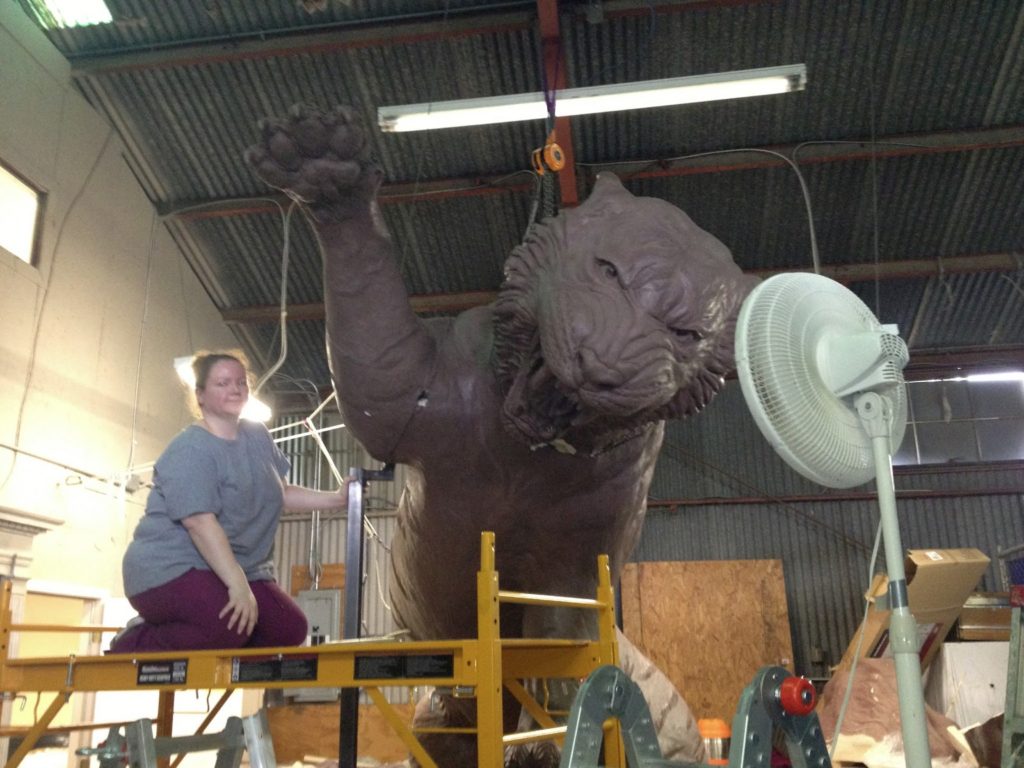
The paw before it was changed.
We Have Our Approval
Grambling State University promised to get me an approval on the tiger within 24 hours of sending pictures. I did tell them there were a few minor changes I was going to do to the sculpture. The chest and arms needed a different type of fur, the tail was not complete, and of course there are more rocks under this cat.
The left back paw was temporarily modified for this armature, but will be fixed in the final sculpture.
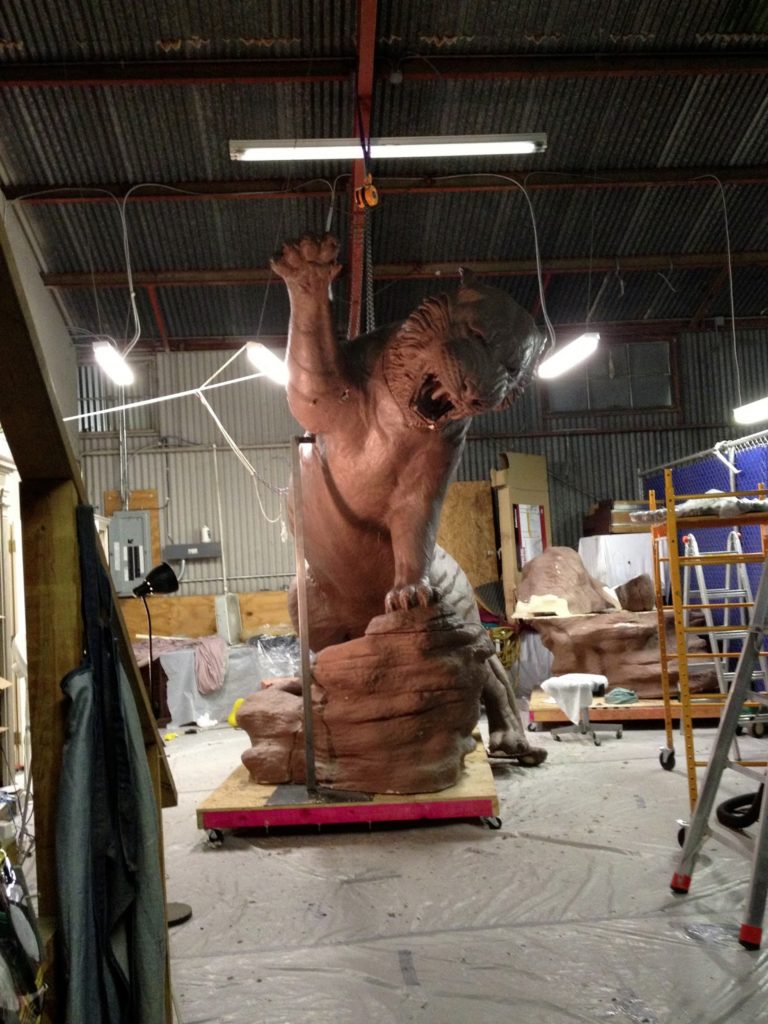
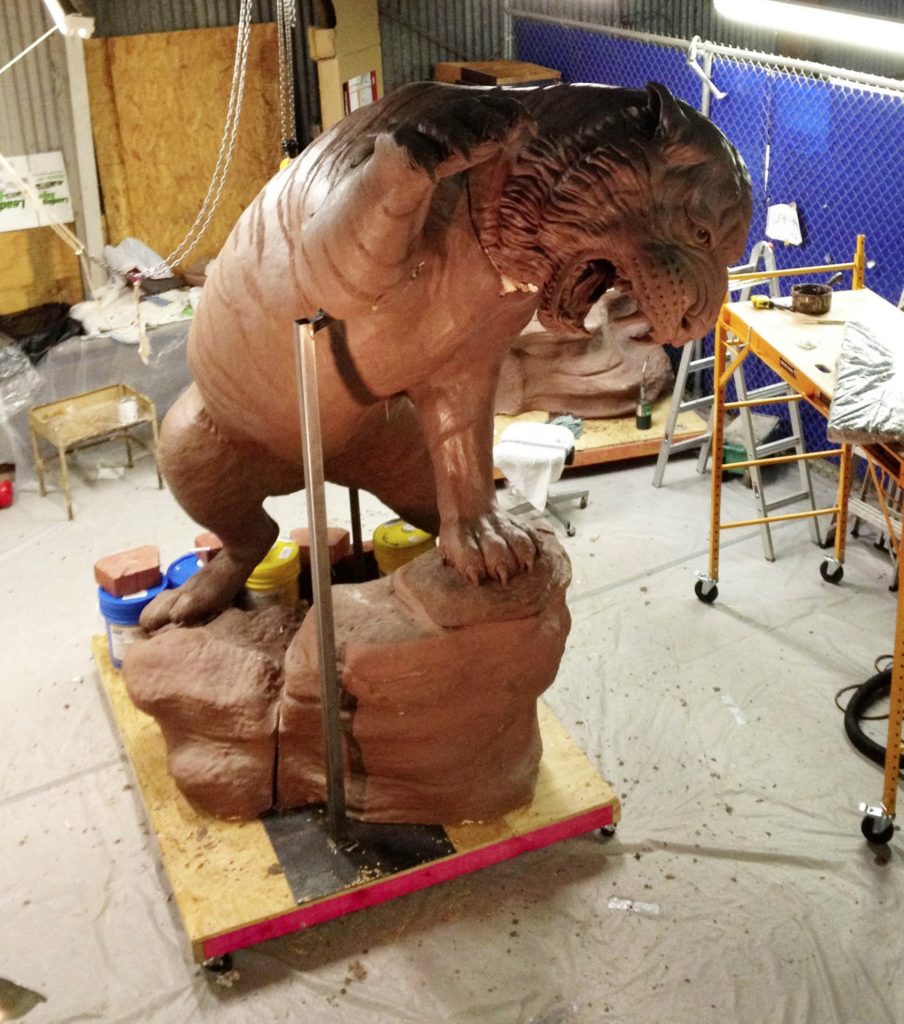
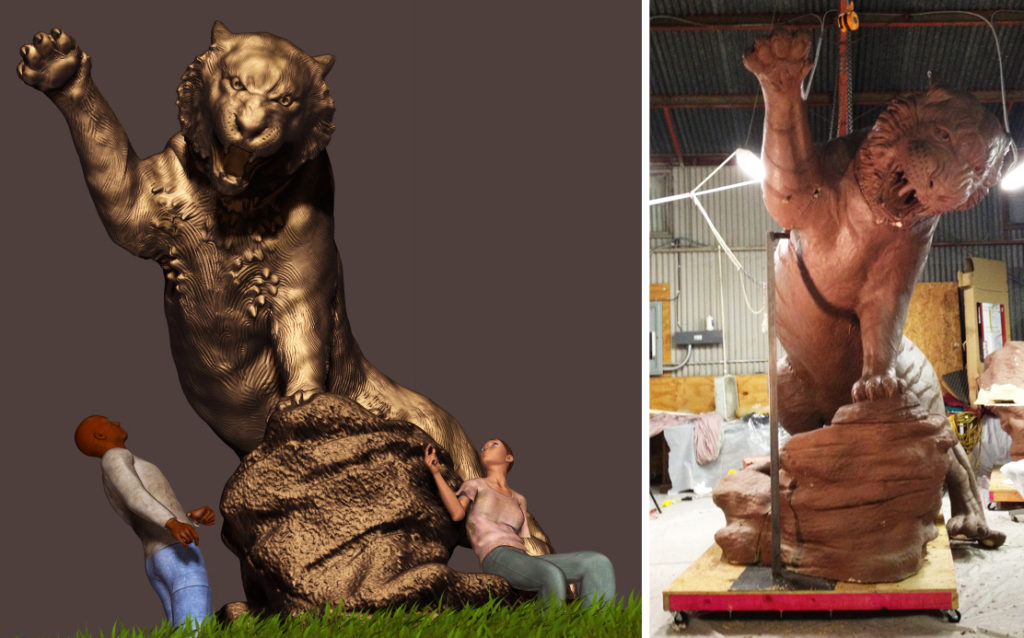
A view of the digital model used in our proposal and the final version.

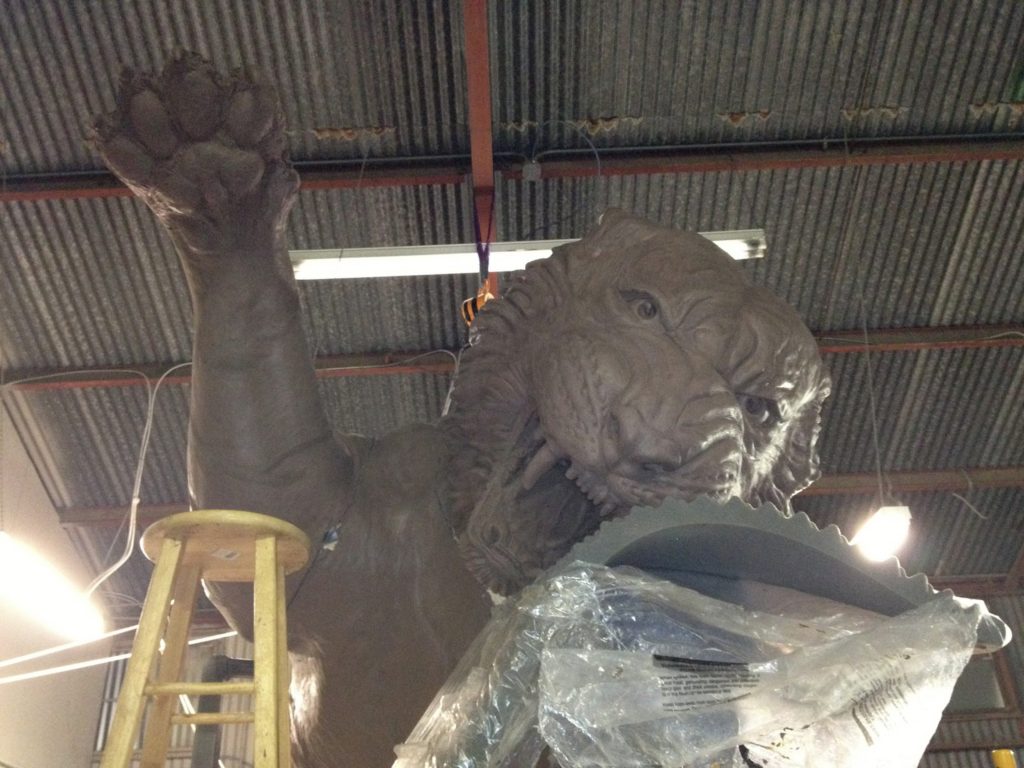
Visitors
My family and friends have not seen me in a very long time. I have been working on the tiger night and day. My hope is to get it finished before homecoming. No promises, but I’m really kicking it trying to get it done.
So, I opened the warehouse to a select few to come and see the finished creation. I was waiting for approval anyway, so I decided to make the most of it.
